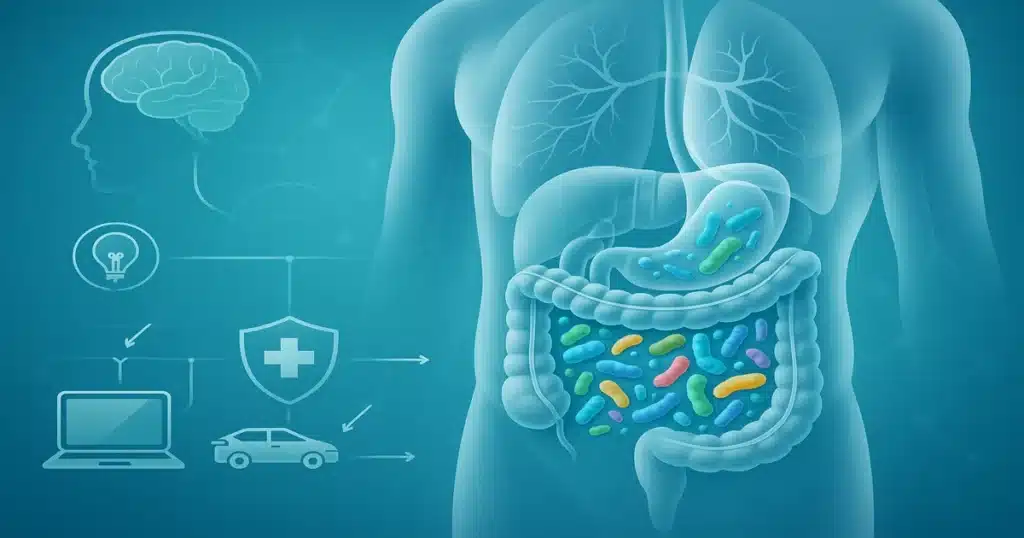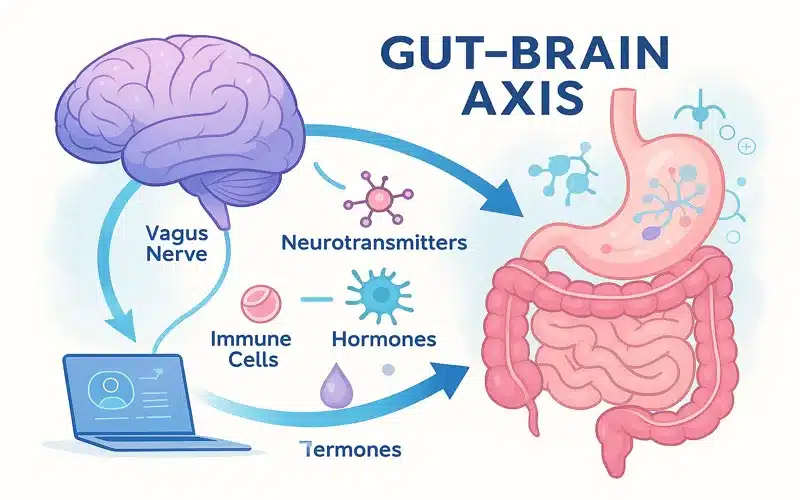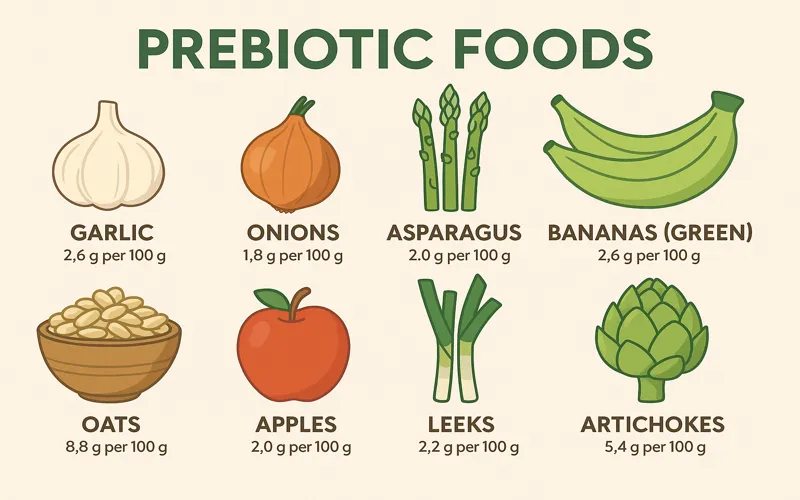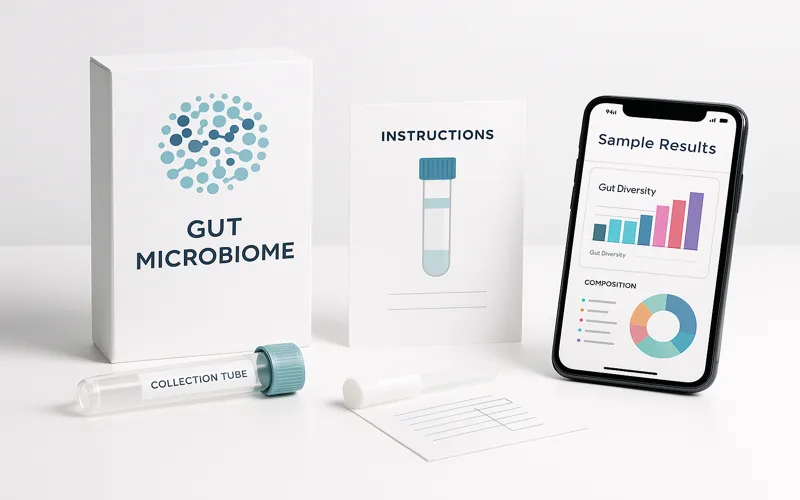⚠️ Medical Disclaimer: This article is for informational purposes only and does not constitute medical advice. The information contained herein is not a substitute for and should never be relied upon for professional medical advice. Always consult your doctor or qualified healthcare provider about any concerns regarding your gut health or digestive symptoms.

⏱️ 14 min read | 📅 Updated November 23, 2025 | ✍️ Medically Reviewed Content
Introduction: The Gut Health Revolution
The conversation around gut health in 2025 has expanded far beyond digestive comfort alone. Your gut microbiome—the trillions of microorganisms living in your digestive tract—serves as a fundamental pillar of overall wellness, influencing everything from immune function to mental health. This complex internal ecosystem, sometimes called our “second brain,” communicates with virtually every system in your body through multiple pathways, including the gut-brain axis.
Research continues to reveal that nurturing this microbial community is one of the most impactful things we can do for our health. Modern threats like processed foods, chronic stress, and antibiotic overuse can disrupt this delicate balance, but the good news is that we have more power to influence our microbiome than previously thought.
This comprehensive guide provides science-backed, practical strategies to help you transform your digestive wellness and harness the profound systemic benefits of a healthy gut.
Related: Health Trends 2025 | Weight Loss Science 2025
Understanding Your Microbiome: Your Internal Ecosystem
What Exactly Is the Gut Microbiome?
Imagine a bustling city on a weekday morning, the sidewalks flooded with people rushing to their destinations. Now picture this at a microscopic level inside your body, and you have a sense of the gut microbiome. This thriving community consists of trillions of microorganisms (bacteria, fungi, viruses, and other microbes) representing thousands of different species, with the largest populations residing in your small and large intestines.
These microbes aren’t just passive residents; they perform essential functions that our own bodies cannot. They synthesize certain vitamins (including B vitamins and vitamin K), break down potentially toxic food compounds, and stimulate the immune system. A healthy gut maintains a balance where most microorganisms are symbiotic (benefiting both the microbes and your body), while a smaller number are pathogenic (potentially disease-promoting). When this balance is disrupted—a state known as dysbiosis—the body becomes more susceptible to disease.
How Your Microbiome Develops and Thrives
Your unique microbial fingerprint begins at birth, shaped initially by delivery method (vaginal vs. C-section) and early feeding (breastmilk vs. formula). Throughout your life, your microbiome remains dynamic, influenced significantly by:
- Diet: One of the most powerful levers for changing your microbiome
- Environment: Exposure to different bacteria in your daily life
- Medications: Particularly antibiotics, which can drastically reduce microbial diversity
- Genetics: Your individual genetic blueprint plays a role
- Stress: Chronic stress alters microbiome composition
The key to a resilient microbiome is diversity. Just as a diverse ecosystem is more stable, a gut populated with a wide variety of beneficial microbes is better equipped to handle challenges and protect your health.
The Gut-Brain Connection: Your Second Brain

The communication network between your gut and brain, known as the gut-brain axis, is one of the most exciting areas of scientific discovery in 2025. This bidirectional highway involves neural, hormonal, and immune pathways, with the vagus nerve serving as a major information superhighway.
Your gut microbes produce a vast array of neuroactive compounds, including an estimated 90-95% of your body’s serotonin—a key neurotransmitter regulating mood, appetite, and sleep. This explains why gastrointestinal distress can be both a cause and a product of anxiety and stress.
Emerging research from institutions like UCLA and published in Cell Reports (October 2025) continues to explore how specific probiotic strains may help support mental wellness by modulating this intricate communication system, potentially offering new avenues for supporting mood and cognitive function through gut health.
Learn more: Workplace Mental Health 2025
Gut Health and Immunity: Your First Line of Defense
An astonishing 70-80% of your immune system resides in your gut, making your digestive tract the body’s primary interface with the outside world. The gut-associated lymphoid tissue (GALT) is the largest immune organ in the body, and it relies heavily on interactions with a balanced microbiome.
Your gut bacteria train immune cells to distinguish between foreign invaders and your own tissues, helping to prevent inappropriate immune responses. They also strengthen the gut barrier—a single layer of cells that prevents harmful substances from entering the bloodstream—and regulate inflammation throughout the body.
An imbalance in gut bacteria can disrupt these critical functions, potentially contributing to inflammatory and autoimmune conditions. Recent studies published in Nature and the Journal of Cell Research (2025) have confirmed the profound impact of microbiome composition on systemic immunity.
Signs of Poor Gut Health: Listening to Your Body
Recognizing the signs of an imbalanced gut is the first step toward healing. Symptoms can be both digestive and surprisingly systemic, affecting areas far beyond your gut.
Digestive Symptoms:
- Bloating, gas, and abdominal discomfort after meals
- Constipation, diarrhea, or irregular bowel movements
- Heartburn or acid reflux
- Food intolerances that develop suddenly
Systemic and Unexpected Signs:
- Skin conditions like acne, eczema, or rosacea
- “Brain fog,” difficulty concentrating, or frequent headaches
- Mood changes, including increased anxiety or low mood
- Frequent infections or weakened immune response
- Unexplained fatigue and sleep disturbances
- Sugar cravings, particularly for refined carbohydrates
Foods That Heal Your Gut: Building a Microbiome-Friendly Diet
Prebiotic Foods: Fuel for Your Good Bacteria
Prebiotics are specialized plant fibers that act like fertilizer for the beneficial bacteria in your gut. They aren’t digested by you but are fermented by your gut microbiota in the colon, producing short-chain fatty acids (SCFAs) like butyrate that maintain gut barrier integrity and reduce inflammation.

| Food Source | Prebiotic Fiber Type | How to Incorporate |
|---|---|---|
| Garlic, Onions, Leeks | Inulin, FOS | Add to soups, sauces, stir-fries |
| Asparagus, Artichokes | Inulin | Roast as side dish or add to salads |
| Green Bananas | Resistant Starch | Add to smoothies or use in baking |
| Oats, Barley | Beta-Glucan | Enjoy as hot cereal or in baked goods |
| Apples | Pectin | Eat with skin on as a snack |
Daily Goal: Aim for 5-10 grams of prebiotic fiber daily. Introduce these foods gradually if you’re not used to them to minimize gas and bloating.
Probiotic Foods: Adding Beneficial Bacteria
Probiotics are live microorganisms that, when consumed in adequate amounts, can support gut balance. They’re found in fermented foods and can help introduce beneficial strains to your ecosystem.

| Food | Key Benefits | Serving Suggestion |
|---|---|---|
| Yogurt with Live Cultures | Lactobacillus, Bifidobacterium strains | Choose plain, unsweetened varieties |
| Kefir | Diverse bacterial strains plus beneficial yeasts | Drink alone or blend into smoothies |
| Sauerkraut, Kimchi | Lactobacillus species | Add 1-2 tablespoons to meals |
| Kombucha | Various bacterial strains | Limit to 1 serving daily due to acidity |
| Miso, Tempeh | Beneficial fermentation byproducts | Use in soups, dressings, stir-fries |
Daily Goal: 1-2 servings of fermented foods daily. When buying commercially, look for “live and active cultures” on the label and avoid pasteurized products, as this kills beneficial bacteria.
Additional Gut-Supportive Foods
- Fiber-Rich Foods: Aim for 25-35g of diverse fiber daily from vegetables, fruits, whole grains, legumes, nuts, and seeds. Different fibers feed different bacteria, so variety matters.
- Polyphenol-Rich Foods: These plant compounds act as antioxidants and fuel for beneficial bacteria. Excellent sources include berries, dark chocolate (70%+ cocoa), green tea, extra virgin olive oil, and coffee.
- Bone Broth: Contains collagen and amino acids like glycine and glutamine that may support gut lining health.
Related: AI Nutrition Apps 2025
Foods and Habits That Harm Gut Health: What to Limit
Just as some foods build a healthy microbiome, others can disrupt its delicate balance:
- Artificial Sweeteners: Research suggests sweeteners like aspartame and sucralose may negatively impact beneficial gut bacteria
- Processed Foods and Added Sugars: Promote growth of less desirable bacteria and yeast while lacking beneficial nutrients
- Excessive Alcohol: Regular heavy consumption can damage the gut lining and alter microbiome composition
- NSAID Overuse: Frequent use of ibuprofen can increase intestinal permeability
- Chronic Stress: Sustained high stress alters gut bacteria composition and weakens digestive function
- Unnecessary Antibiotics: While life-saving when needed, antibiotics dramatically reduce microbial diversity
Probiotic and Prebiotic Supplements: A 2025 Guide
When Supplements Can Help
While food should be your foundation, high-quality supplements can be beneficial in specific situations:
- During and after a course of antibiotics
- When experiencing digestive issues like occasional bloating or irregularity
- During periods of high stress
- When traveling, to support microbial stability
Choosing a Quality Probiotic
The probiotic supplement market has evolved significantly. When selecting a probiotic:
- Look for Multiple Strains: Different strains offer different benefits. Common beneficial genera include Lactobacillus and Bifidobacterium
- Check the CFU Count: Products typically range from 1-100 billion CFUs (colony-forming units). More isn’t necessarily better—different conditions respond to different doses
- Seek Third-Party Testing: Choose brands that verify their products through independent testing
- Consider Your Needs: Different strains have different researched benefits. Some Lactobacillus strains may support immune health, while certain Bifidobacterium strains may help with regularity
Other Supportive Supplements
- Prebiotic Fiber: Options like inulin, FOS, or PHGG can help if you struggle to get enough from food. Start with a low dose
- L-Glutamine: Serves as fuel for intestinal lining cells and may support gut barrier repair
- Digestive Enzymes: Can provide temporary support while addressing underlying issues
Lifestyle Factors: Beyond the Plate
A holistic approach to gut health acknowledges that what happens outside the kitchen matters just as much as what happens inside it.
Stress Management

Chronic stress can alter gut motility, reduce blood flow to digestive organs, and change microbiome composition. Effective strategies include:
- Regular meditation or mindfulness practice (10-20 minutes daily)
- Yoga or tai chi, which combine movement with breath awareness
- Deep breathing exercises to stimulate the vagus nerve
- Time in nature to lower stress hormones
Learn more: Fitness Tips 2025
Movement and Exercise
Regular physical activity is associated with increased microbiome diversity. Aim for:
- Moderate cardio (30 minutes, 5 times per week)
- Strength training (2-3 times per week)
- Movement throughout the day (not just structured workouts)
Sleep Hygiene
Your gut bacteria follow circadian rhythms, and disrupted sleep can negatively impact your microbiome. Prioritize:
- 7-9 hours of quality sleep nightly
- Consistent sleep and wake times, even on weekends
- A dark, cool, technology-free bedroom
Testing Your Gut Health: A 2025 Perspective

Advanced testing options now provide unprecedented insights into your microbiome. Comprehensive stool tests from companies like Viome, Thorne, Ombre, and Tiny Health can analyze your microbial diversity, identify specific strains, and detect potential imbalances.
These tests typically cost between $100-400 and can be valuable for:
- Identifying specific pathogenic overgrowths
- Understanding your unique microbial signature
- Getting a baseline measurement before making lifestyle changes
Important Note: They’re not essential for everyone. Many people can significantly improve gut health by implementing the fundamental dietary and lifestyle strategies outlined in this guide. For persistent, serious digestive symptoms, working with a healthcare professional for testing and interpretation is recommended.
Healing Protocol: A 4-Week Gut Reset

If you’re feeling overwhelmed, this simple 4-week plan provides a structured approach to begin healing your gut:
Weeks 1-2: Elimination & Foundation
- Eliminate processed foods, added sugars, and artificial sweeteners
- Add 1-2 servings of prebiotic foods daily
- Incorporate 1 tablespoon of fermented food daily
- Focus on chewing thoroughly and eating in a relaxed state
Weeks 3-4: Building & Diversifying
- Increase to 2+ servings of fermented foods daily
- Aim for 30+ different plant foods weekly
- Consider adding a quality probiotic supplement
- Implement a consistent sleep schedule (7-9 hours)
- Add daily stress management practice (meditation, yoga, or breathwork)
Tracking Progress:
- Keep a simple journal of digestion, energy, mood, and symptoms
- Note non-digestive changes like skin clarity or mental focus
- Be patient—significant changes can take 3-6 months
When to See a Doctor:
Consult a healthcare professional if you experience persistent symptoms like unexplained weight loss, blood in stool, severe pain, or symptoms that significantly impact your quality of life.
Conclusion: Your Journey to Gut Health Begins Now
The path to better gut health in 2025 is one of the most impactful investments you can make in your overall wellbeing. While the science is complex, the practical steps are often simple: feed your beneficial bacteria with diverse fibers, include fermented foods, manage stress, and prioritize sleep.
Remember that small, consistent changes compound into significant results over time. Your microbiome is remarkably responsive to your daily choices, and even modest shifts in your diet and lifestyle can begin to transform your internal ecosystem within weeks.
Rather than attempting a complete overhaul overnight, choose one or two strategies from this guide to implement consistently. Whether it’s adding a daily serving of a prebiotic vegetable, taking a few minutes for deep breathing, or swapping a processed snack for a whole-food alternative, every positive choice contributes to a healthier gut. The journey to better health truly does begin in the gut.
Ready to explore more wellness strategies? Check out our guides on evidence-based weight loss, retirement planning, and investment strategies for 2025.
Frequently Asked Questions

How long does it take to improve gut health?
Most people notice some improvements in digestion within 2-4 weeks of consistent dietary changes. However, significant restructuring of the gut microbiome typically takes 3-6 months of sustained effort, as different bacterial species have varying reproduction rates. Some improvements, like reduced bloating or more regular bowel movements, may occur quickly, while deeper changes to microbiome diversity and resilience take longer.
Can I heal my gut naturally without supplements?
Absolutely. While supplements can provide support in certain situations, many people achieve excellent results through dietary changes alone. Focusing on diverse plant foods (30+ varieties weekly), fermented foods (1-2 servings daily), stress management, and good sleep hygiene addresses the foundation of gut health. Food should always be your primary strategy, with supplements used strategically when needed.
What’s the difference between probiotics and prebiotics?
Probiotics are live beneficial bacteria found in fermented foods and supplements. Prebiotics are specialized fibers that act as food for these beneficial bacteria. Think of probiotics as the seeds and prebiotics as the fertilizer for your gut garden. Both are important: prebiotics help existing beneficial bacteria thrive, while probiotics can introduce new beneficial strains.
Should everyone take a probiotic supplement?
Not necessarily. While generally safe for healthy individuals, probiotics aren’t essential for everyone. They can be particularly helpful during/after antibiotics, during high-stress periods, when traveling, or when experiencing digestive issues. However, a diet rich in fermented foods and diverse plant fibers is often sufficient. Those with specific health conditions or compromised immune systems should consult a healthcare professional before starting any new supplement.
Can antibiotics permanently damage gut health?
While antibiotics can significantly reduce microbial diversity, the microbiome is generally resilient and can recover. However, this recovery requires active support through prebiotic and probiotic foods. Some studies suggest certain species may take months or longer to repopulate. To support recovery: take probiotics during and after antibiotics (separated by 2-3 hours), consume fermented foods daily, eat diverse plant fibers, and avoid unnecessary antibiotic courses.
What is leaky gut syndrome?
More accurately called increased intestinal permeability, this refers to a condition where the tight junctions of the intestinal lining become compromised, potentially allowing undigested food particles, bacteria, and toxins to enter the bloodstream. This can trigger inflammation and immune responses. While the term “leaky gut” is debated in medical circles, increased intestinal permeability is a recognized phenomenon that can be addressed through gut-supportive nutrition, stress management, and avoidance of triggers like NSAIDs and excessive alcohol.
How does stress affect gut health?
Chronic stress profoundly impacts gut health through multiple mechanisms: it alters gut motility (causing constipation or diarrhea), reduces blood flow to digestive organs, changes gut bacteria composition toward less beneficial species, increases intestinal permeability, and disrupts the production of digestive enzymes. The gut-brain axis means stress signals from the brain directly affect the gut, and vice versa. This is why stress management—through meditation, exercise, adequate sleep, and relaxation techniques—is a crucial component of gut health.
What foods should I eat every day for gut health?
For optimal gut health, aim to include daily: (1) At least 1-2 servings of fermented foods (yogurt, kefir, sauerkraut, kimchi), (2) 25-35g of diverse fiber from various plant sources, (3) 1-2 prebiotic-rich foods (garlic, onions, asparagus, green bananas), (4) Polyphenol-rich foods (berries, green tea, dark chocolate, olive oil). Focus on variety—eating 30+ different plant foods per week is associated with better microbiome diversity.
Is gut microbiome testing worth it?
Gut microbiome testing can provide valuable insights but isn’t necessary for everyone. It’s most useful if you: have persistent digestive issues despite dietary changes, want to identify specific bacterial imbalances, are curious about your unique microbiome composition, or want objective data to track progress. Tests typically cost $100-400. However, implementing the foundational strategies (diverse plant foods, fermented foods, stress management, good sleep) will benefit most people without testing. Save testing for situations where you need more specific guidance or have complex symptoms.
⚠️ Important Medical Disclaimer
General Information Only
This article is for informational and educational purposes only and does not constitute medical advice. The information contained herein is not a substitute for and should never be relied upon for professional medical advice. Always consult your doctor or other qualified healthcare provider about any concerns you may have regarding your gut health, digestive symptoms, or any medical condition.
Not a Substitute for Professional Care
The content of this article should not be used to diagnose, treat, cure, or prevent any disease or health condition. Individual results may vary, and what works for one person may not work for another. If you have a medical condition, are taking medications, are pregnant or nursing, or have concerns about how dietary changes might affect you, please consult with a qualified healthcare professional before making changes to your diet or lifestyle.
Supplement Safety
Probiotic and prebiotic supplements may not be appropriate for everyone, particularly those with compromised immune systems, serious medical conditions, or those taking certain medications. Always discuss supplement use with your healthcare provider.
When to Seek Medical Attention
Seek immediate medical attention if you experience: persistent or severe abdominal pain, blood in stool, unexplained weight loss, persistent vomiting or diarrhea, difficulty swallowing, or any symptoms that concern you or significantly impact your quality of life.
Last Updated: November 23, 2025
About This Content
This comprehensive guide was researched and compiled by the health research team at Sezarr Overseas, utilizing peer-reviewed studies from leading scientific journals including Nature, Cell Reports, FEMS Microbiology Ecology, and databases from the National Library of Medicine (PMC). All statistics and health claims have been verified from authoritative sources published in 2025.
Sources include: National Institutes of Health (NIH), University of Gothenburg (Cell Reports October 2025), UCLA Microbiome Research, Nature Cell Research (2025), and FEMS Microbiology Ecology (May 2025).
Found this helpful? Share with others:
Facebook | Twitter | Pinterest | LinkedIn
Related Health & Wellness Articles
- Health Trends 2025: What’s Shaping Wellness This Year
- Weight Loss Science 2025: Evidence-Based Strategies That Work
- Fitness Tips 2025: Science-Backed Strategies for Optimal Health
- Workplace Mental Health 2025: Action Framework
- AI Nutrition Apps 2025: Market Analysis and Trends
- How AI Wellness Apps Transform Personalized Healthcare
- Retirement Planning 2025: Complete Guide
- Investment Strategies 2025: Expert Analysis